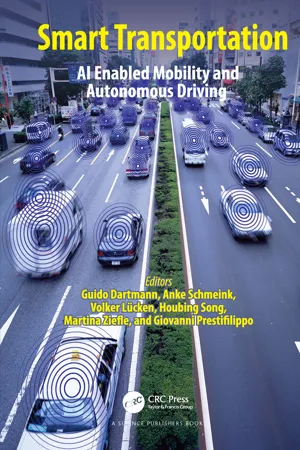
Smart Transportation
AI Enabled Mobility and Autonomous Driving
- 200 pages
- English
- ePUB (mobile friendly)
- Available on iOS & Android
Smart Transportation
AI Enabled Mobility and Autonomous Driving
About this book
The book provides a broad overview of the challenges and recent developments in the field of smart mobility and transportation, including technical, algorithmic and social aspects of smart mobility and transportation. It reviews new ideas for services and platforms for future mobility. New concepts of artificial intelligence and the implementation in new hardware architecture are discussed. In the context of artificial intelligence, new challenges of machine learning for autonomous vehicles and fleets are investigated. The book also investigates human factors and social questions of future mobility concepts.
The goal of this book is to provide a holistic approach towards smart transportation. The book reviews new technologies such as the cloud, machine learning and communication for fully atomatized transport, catering to the needs of citizens. This will lead to complete change of concepts in transportion.
Frequently asked questions
- Essential is ideal for learners and professionals who enjoy exploring a wide range of subjects. Access the Essential Library with 800,000+ trusted titles and best-sellers across business, personal growth, and the humanities. Includes unlimited reading time and Standard Read Aloud voice.
- Complete: Perfect for advanced learners and researchers needing full, unrestricted access. Unlock 1.4M+ books across hundreds of subjects, including academic and specialized titles. The Complete Plan also includes advanced features like Premium Read Aloud and Research Assistant.
Please note we cannot support devices running on iOS 13 and Android 7 or earlier. Learn more about using the app.
Information
CHAPTER
1
Social Acceptance of Autonomous Driving – The Importance of Public Discourse and Citizen Participation
1.1 Introduction – Automated Driving: Aims, Status Quo, Challenges
1.2 Social Acceptance – Its Role for and the Inclusion of Potential Users
- Identify stages in the development cycle whe...
Table of contents
- Cover
- Title Page
- Copyright Page
- Preface
- Acknowledgements
- Contents
- 1. Social Acceptance of Autonomous Driving – The Importance of Public Discourse and Citizen Participation
- 2. Artificial Intelligence for Autonomous Vehicle Fleets: Desired Requirements, Solutions and a Best Practice Project
- 3. Large-scale Simulation of a Mobility-on-Demand System for the German City Aachen
- 4. Artificial Intelligence for Fleets of Autonomous Vehicles: Desired Requirements and Solution Approaches
- 5. Future Urban Mobility: Designing New Mobility Technologies in Open Innovation Networks
- 6. Communication and Service Aspects of Smart Mobility: Improving Security, Privacy and Efficiency of Mobility Services by Utilizing Distributed Ledger Technology
- 7. Pseudonym Management through Blockchain: Cost-efficient Privacy Preservation on Smart Transportation
- 8. Simulation Platforms for Autonomous Driving and Smart Mobility: Simulation Platforms, Concepts, Software, APIs
- 9. Deep-Learning Based Depth Completion for Autonomous Driving Applications
- 10. Artificial Intelligence Based on Modular Reinforcement Learning and Unsupervised Learning
- 11. Functional Safety of Deep Learning Techniques in Autonomous Driving Systems
- Index